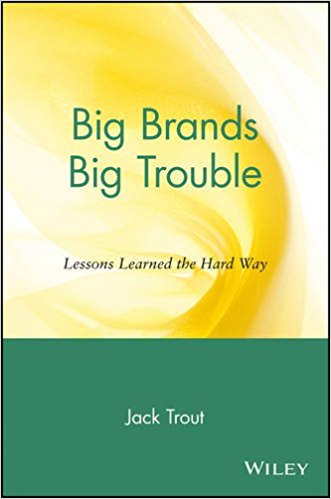Big Brands Big Trouble Summary
5 min read ⌚
 Lessons Learned the Hard Way
Lessons Learned the Hard Way
Jack Trout enforces the fishing technique. In order to catch a big fish, you need a good bait, and he knows how to intrigue customers.
Who Should Read “Big Brands Big Trouble”? And Why?
“Big Brands Big Trouble” comes highly recommended to those individuals, who want to learn the techniques of managing large enterprises, and the challenges which occur along the way. The process of facing these obstacles, serve as a mirror, to indicate what matters require extra attention.
As an illustration of this point, the author lays out some concepts that are proven to be useful in all industries. You can further investigate, what does suit your business or doesn’t, but at the end of the day, – Big Brands, carry Big Trouble.
About Jack Trout
 As we said earlier, Jack Trout is the co-founder of a U.S. based marketing and consulting company – Trout & Partners, operating in 12 different countries.
As we said earlier, Jack Trout is the co-founder of a U.S. based marketing and consulting company – Trout & Partners, operating in 12 different countries.
The client’s database includes brands like AT&T, Merrill Lynch, Coca-Cola and Southwest Airlines.
He was born on January 31st, 1935 in New York, and passed away on June 4th, 2017.
“Big Brands Big Trouble Summary”
Today’s topic starts with an ironical anecdote – brands like IBM, Digital Equipment and others, portrayed as untouchable leaders in – In Search of Excellence – have run into serious issues, mostly operational. In other words, not even the so-called – flawless brands are able to cope with severe challenges existing nowadays.
In fact, the bigger the company, the bigger the problems. Don’t get this the wrong way, because sometimes phrases like this can misguide you into making conclusions that are not even close, to the actual situation.
People often think that these corporations endured for so long being among the top-notch enterprises, due to their flawlessness, and the ability to avoid getting into trouble.
Don’t be deceived by this claim, and think logically, how can an organization of thousands of people, operate efficiently without room for miscalculations and mispredictions.
These brands step-by-step gained influence beyond corporation borders and consequently received far more responsibilities. In addition, the reputation building process relies on not just the right calls, but also decisions that you’ve wished never happened.
Ordinary individuals think that brands have no tolerance for human errors – an entirely false theory! Of course, everyone tries to improve the decision-making potential, but at what cost? Getting in touch with your end-customers is the essence of designing a profitable business objective.
However, that’s easier said than done, due to globalization, and intense competition is troubling the start-ups these days. Your task, as an executive, owner, manager or associate is to investigate what is the cause of failing to adapt.
The sooner you have access to the information that troubles your company, the better. Afterwards, you can focus on understanding the processes, which interfere in making the system function in a way it shouldn’t.
According to experts, one of the biggest mistakes typical for modern companies is relying strictly on production and operational activities. Obviously, the cutting-edge technology you use to develop these commodities is important but not crucial.
For instance, if a successful, well-established brand has most of the market share in your industry, you’ll probably have a hard time in order to position your brand well on the market – regardless of whether you have the better product.
The head of the marketing firm Trout & Partners – Jack Trout draws from his own experience and seeks for details related to any information potentially leading to the explanation of why big brands, get into big troubles. Messing up things is an integral part of our nature, thereby the goal is to reduce these miscalculations.
Inaccuracies and economic setbacks burst the bubble of prosperity, but not destroying it.
The irony leading to inconsistencies have a close relationship with profits. Frequently, big brands tear up those concepts which have shown a dose of inaccuracy in the past. The quality loss emerges from different reasons, but it doesn’t damage the picture that a certain brand represents.
The breakdown stories reflect some of the processes unfolding in Coca-Cola, AT&T, Xerox, Digital Equipment, etc.
CEOs, biased Board of Directors and incompetent managers are the guilty party, become they have a hard time trying to keep everyone on their toes.
Key Lessons from “Big Brands Big Trouble”
1. Presentation takes the front seat in avoiding troubles
2. The perfect ratio
3. The switching brand practice is killing the companies
Presentation takes the front seat in avoiding troubles
How you present your offerings, is 9/10 times more valuable asset in brand-building than emphasizing the quality of products.
Perception has a huge role, because customers inflict judgment on your product, mostly referring to the message being delivered.
In either case, comprehend that the world of marketing requires creativity, which covers perhaps all the product disadvantages.
The perfect ratio
Customers are crucial for any organization, you as a manager should focus on finding the ideal ratio between production/customer-centric perspective.
It’s hardly possible to intertwine these two, without reducing the effect from at least one of them.
The switching brand practice is killing the companies
Let’s cut right to the chase, and analyze what creates loyal customers, and why switching brands has become common practice nowadays.
The Digital Age offers thousands of new possibilities; it’s not like the old days when people had a few options.
That leads to the development of a new business platform, which targets the unique preferences of target groups.
Although gaining a competitive edge is the final goal for any company, often firms lose that advantage in a blink of an eye due to various reasons.
Like this summary? We’d Like to invite you to download our free 12 min app, for more amazing summaries and audiobooks.
“Big Brands Big Trouble” Quotes
Benchmarking doesn’t work because regardless of a product’s objective quality, people perceive the first brand to enter their mind as superior. Share on X Most failed brands once had a good idea that they undermined by adding more and more versions. Share on X Consumers have so many choices that one false step brings not just one, but an army of competitors to take advantage of your misstep. Share on X When a competitor owns a word or position in the prospect’s mind, it is futile to attempt to own the same idea. Share on X All that exists in the world of marketing are perceptions in the minds of customers or prospects. The perception is the reality. Everything else is illusion. Share on XOur Critical Review
To sum it up, let’s move one step back and discuss this branding debacle that occurs once in a while.
Trout underlines corporate deficiencies and puts the blame on companies with a shallow perspective.
Such claim if understood properly, can give you the advantage when concluding deals, and running your business.
Emir is the Head of Marketing at 12min. In his spare time, he loves to meditate and play soccer.


 Lessons Learned the Hard Way
Lessons Learned the Hard Way




